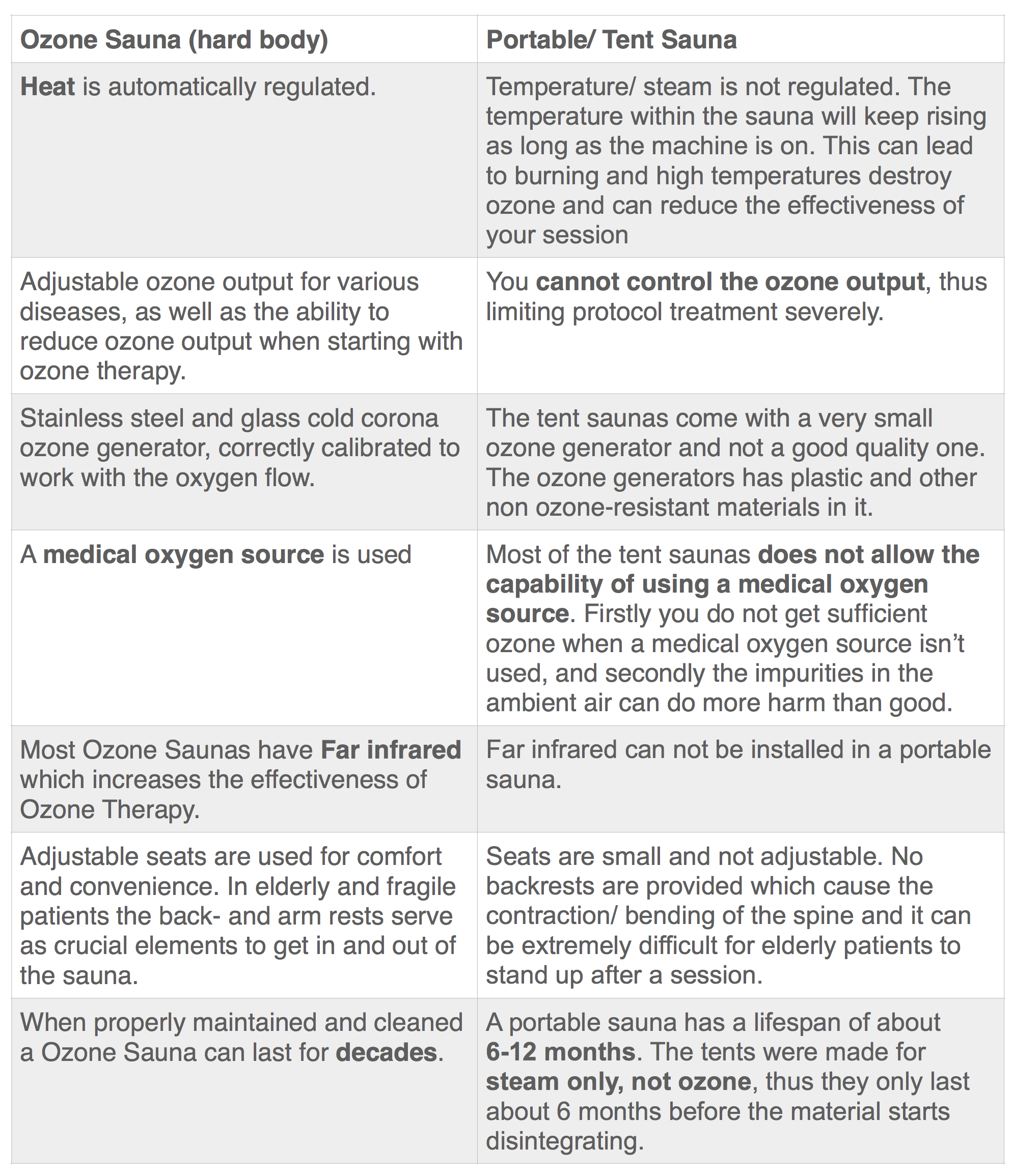Ozone Sauna Buyers Guide & FAQ
Get to know more about the right ozone sauna for you, find answers to common questions and learn more about how it all works.
Over the last few years we have had many people contacting us confused about which sauna is best for them. Some people lost money by buying the wrong product, others had negative health consequences as the sauna they purchased didn’t deliver on it’s (often misguided) intended health benefits.
We created this guide as a tool and info sheet, not just information about Ozone Saunas (commonly referred to as ozone pods, ozone capsules, ozone cabinets, ozone steam sauna, HOCATT, ozone steam spa/bath, ozone therapy machines etc), but also on other types of saunas.
Would you like to display this infographic on your website?
Use the code below to easily embed the image on your website:
[message_box type="inset"]<a href="https://salvagente.co.za/ozone-sauna-buyers-guide/" target="_blank"><img src="http://goo.gl/tncGY1" alt="The Pros and Cons of Saunas" width="708" height="2834" title="The Pros and Cons of Saunas” style=“border:none;"></a>[/message_box]
This Ozone Sauna Buyers Guide shows the minimum required equipment when either getting or administering Ozone Therapy with a Sauna
Frequently Asked Questions
Portable/ tent sauna VS Ozone Sauna

- Most of the wooden saunas does not allow for your head to stick out, thus you will be inhaling ozone the duration of the session which can be harmful.
- You cannot connect a medical oxygen source to create pure ozone on a wooden sauna.
- The wood can become toxic once the ozone reaches the absorption point in the wood.
Hyperbaric Oxygen vs Ozone Sauna
| Therapy | How It Works | Benefits | Drawbacks | Cost | Availability |
| Medium Hyperbaric Oxygen Chambers (mHBOT) | Enclosed in a sealed soft material chamber, breathing oxygen at lower pressures (1 ATA - 1.4 ATA), at lower oxygen concentrations (24%-93%) | Wound healing and immune support. | Lower effectiveness compared to HBOT chambers and ozone saunas | Moderate ($13,000 - $30,000) | Specialised clinics, wellness centres |
| Ozone Steam Saunas | Full body exposure to ozone gas in a steam environment while your head is OUTSIDE of the sauna. | Detoxification & cosmetics, health & medical applications, sports benefits. | Potential respiratory issues, ozone exposure risks | Affordable ($8,000 - $20,000) | Home use, spas, wellness centres |
|
Aspect |
Hyperbaric Oxygen Therapy (mHBOT) |
Ozone Steam Sauna Therapy |
|
Healing |
Enhanced healing due to increased oxygen levels. |
Promotes healing through ozone’s anti-inflammatory, -bacterial, -viral, -fungal, -microbial and antioxidant properties. |
|
Neurological Benefits |
May improve cognitive function and brain injury recovery. |
Limited research on direct neurological benefits. |
|
Immune Support |
Boosts immune function by enhancing white blood cell activity. |
Immunomodulatory and supports immune system by eliminating toxins and pathogens. |
|
Cost |
More expensive; mHBOT 2-3x, HBOT 10x the cost of ozone saunas. |
More cost-effective. |
|
Contraindications |
Not suitable for lung disease, ear problems, claustrophobia, barotrauma. |
Generally well-tolerated, but can cause temporary irritation. |
|
Time Investment |
Sessions longer (60-90 minutes). |
Sessions shorter (30 minutes). |
|
Space |
HBOT large and bulky, mHBOT larger than ozone saunas. |
Ozone saunas are smaller and more movable. |
|
Infections |
Effective for infections causing tissue death and non-healing wounds. |
Effective in reducing ulcer areas, but mHBOT may show better results. |
|
Performance and Recovery |
Increased oxygen delivery leads to short-term performance gains and faster recovery. |
Can improve performance and recovery by reducing inflammation. |
|
Tissue Treatment |
Effective for healing tissue after skin grafts or flaps. |
Similar results to HBOT in tissue regeneration observed in some studies. |
|
Factor |
Hyperbaric Oxygen Therapy (HBOT) |
Ozone Steam Sauna Therapy |
|
Suitability |
Specific conditions like severe wounds or carbon monoxide poisoning |
Wider range of ailments |
|
Other Therapy Options |
Limited |
Multiple therapy modalities (like Far Infrared, Red/Blue Light Therapy, Aromatherapy etc) in one device |
|
Cost |
More expensive |
More cost-effective |
Technical & Maintenance
Health
- Athletes or similar: 5 sessions every or every other day, especially before and after athletic events.
- Healthy individuals can have 2-3 sessions a week for a month, thereafter 10 sessions per month.
- Unhealthy individuals can have 3-4 sessions a week for 2 months, thereafter 10 sessions per month.
- Chronically ill individuals can have 3-4 sessions a week for 3 months, thereafter 3 sessions per week.
